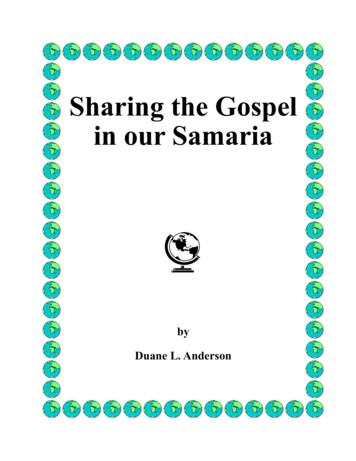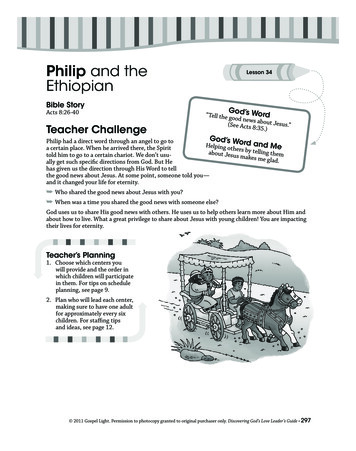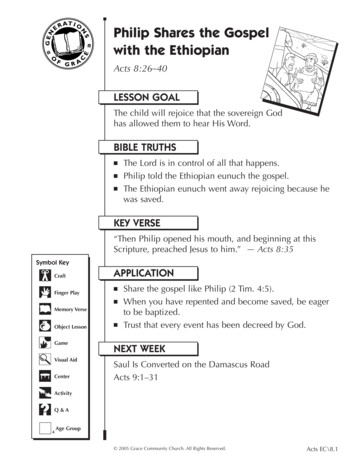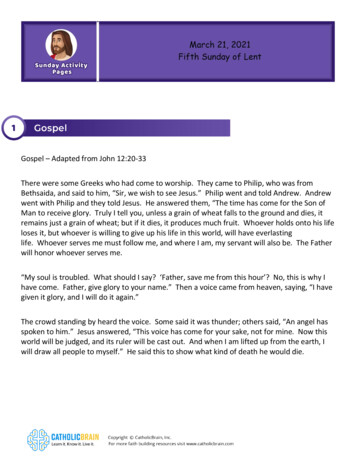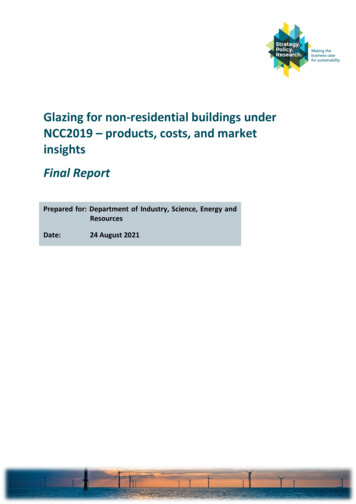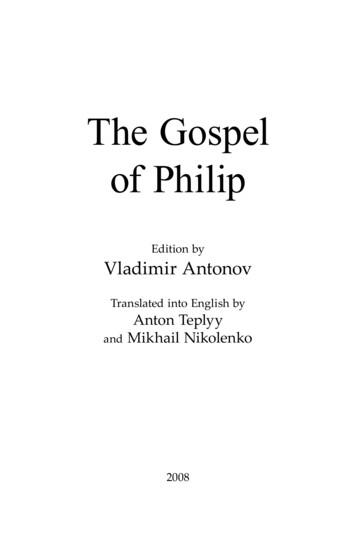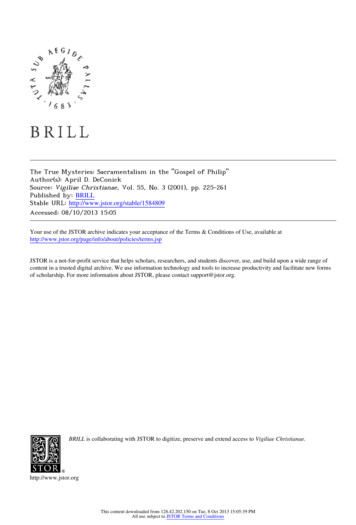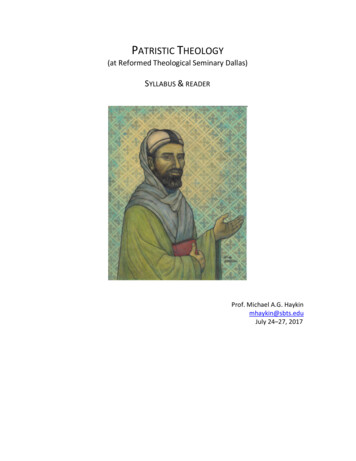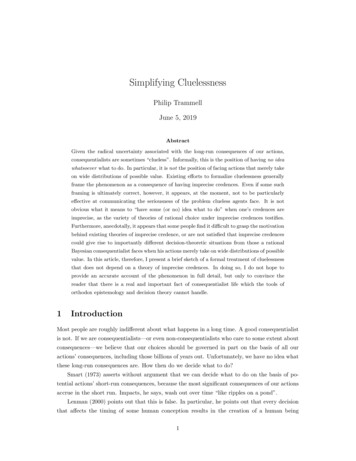
Transcription
Simplifying CluelessnessPhilip TrammellJune 5, 2019AbstractGiven the radical uncertainty associated with the long-run consequences of our actions,consequentialists are sometimes “clueless”. Informally, this is the position of having no ideawhatsoever what to do. In particular, it is not the position of facing actions that merely takeon wide distributions of possible value. Existing efforts to formalize cluelessness generallyframe the phenomenon as a consequence of having imprecise credences. Even if some suchframing is ultimately correct, however, it appears, at the moment, not to be particularlyeffective at communicating the seriousness of the problem clueless agents face. It is notobvious what it means to “have some (or no) idea what to do” when one’s credences areimprecise, as the variety of theories of rational choice under imprecise credences testifies.Furthermore, anecdotally, it appears that some people find it difficult to grasp the motivationbehind existing theories of imprecise credence, or are not satisfied that imprecise credencescould give rise to importantly different decision-theoretic situations from those a rationalBayesian consequentialist faces when his actions merely take on wide distributions of possiblevalue. In this article, therefore, I present a brief sketch of a formal treatment of cluelessnessthat does not depend on a theory of imprecise credences. In doing so, I do not hope toprovide an accurate account of the phenomenon in full detail, but only to convince thereader that there is a real and important fact of consequentialist life which the tools oforthodox epistemology and decision theory cannot handle.1IntroductionMost people are roughly indifferent about what happens in a long time. A good consequentialistis not. If we are consequentialists—or even non-consequentialists who care to some extent aboutconsequences—we believe that our choices should be governed in part on the basis of all ouractions’ consequences, including those billions of years out. Unfortunately, we have no idea whatthese long-run consequences are. How then do we decide what to do?Smart (1973) asserts without argument that we can decide what to do on the basis of potential actions’ short-run consequences, because the most significant consequences of our actionsaccrue in the short run. Impacts, he says, wash out over time “like ripples on a pond”.Lenman (2000) points out that this is false. In particular, he points out that every decisionthat affects the timing of some human conception results in the creation of a human being1
with a totally different genome—and that this can ultimately change the numbers, personalitydistributions, and actions of all future generations. We are thus always radically uncertain, or“clueless”, about our actions’ long-run consequences.Cowen (2006) and Dorsey (2012) argue that, even if our actions have substantial long-runramifications (e.g. changing the “identities” of all future people past some date), the positiveand negative impacts on value associated with an action will tend to cancel out. Short-termconsequences do not serve well as proxies for total consequences, in other words, but short-termvalue serves well as a proxy for total value.Burch-Brown (2014) agrees that we can choose on the basis of relatively direct consequences,but only because uncertainty about long-run/indirect consequences is, ex ante, symmetric acrossacts. When we are deciding whether to conceive a child on a Tuesday or a Wednesday, perhaps,or when we are deciding whether to help an old lady across a street, any chance that one actmight have some long-run positive or negative consequence will be counterbalanced by an equalchance that the other will have that consequence. So we can’t take comfort in the image ofripples on a pond, but we can still use short-run, or direct, impact as a proxy for expected value.Greaves (2016) argues that this does not fully capture the phenomenon of cluelessness. Ouruncertainty in long-run consequences is sometimes symmetric across acts; perhaps it is in thecases described above. In these circumstances, which Greaves terms cases of “simple cluelessness”, we can indeed use short-run impact as a proxy for expected value. In the more interesting(and perhaps more common) cases, though, there is no such symmetry. When we’re decidingwhether to give enough to Malaria Consortium as to save roughly one person from dying ofmalaria—say, 2,000 (GiveWell, 2019)—we must weigh a huge basket of semi-foreseeable positive and negative consequences on the present human population, the future human population,farm animals, wild animals, economic growth, global warming, and very much more. In thesecases of “complex cluelessness”, people are sometimes intuitively inclined to pick out one foreseeable positive consequence (such as the saved child’s life) and proceed as if the expected valueof the cloud of other consequences were zero. But this is not a legitimate move; if it were, wecould just as easily pick out one foreseeable negative consequence (the exacerbation of globalwarming) and proceed as if the expected value of the cloud of other consequences were zero aswell. We would then have to call the expected value of giving to Malaria Consortium positiveand negative at the same time. What to do in cases of complex cluelessness is, she says, an openquestion.I agree. I think complex cluelessness is a substantive and uncrossed roadblock on the wayto a general theory of consequentialist decision-making, and I think it warrants more carefulattention than it gets. I also think it’s the only kind of cluelessness worth the name, so I willjust call it cluelessness for the rest of this article, ignoring the simple variety.11 BesidesGreaves, many in the Effective Altruism community have now begun at least some attempt in thedirection of formalizing and studying the phenomenon of cluelessness (or decision-making under cluelessness),including Amanda Askell, Jesse Clifton, Aidan Goth, Milan Griffes, Andreas Mogensen, Christian Tarsney, BrianTomasik, and Tatjana Visak. There are also of course many professional philosophers and other scholars who have2
2“Just be rational”The most obvious way in which cluelessness differs from the kind of uncertainty that allows forexpected values is phenomenological: the two things feel different. My uncertainty about thenumber of coin flips out of seven that will come up heads can be characterized by a preciseprobability distribution whose mean is 3.5. My uncertainty about the value of a die roll canbe characterized by a different, but also precise, probability distribution whose mean is 3.5. Ifsaving a life causes Nature to flip a coin seven times and save as many additional lives as cameup heads, and failing to save the life causes Nature to do the same, my uncertainty about theacts’ indirect effects is “symmetric”, and I should save the life. If instead saving the life causesNature to roll a die and save as many additional lives as the number that lands on top, myuncertainty about the acts’ indirect effects is no longer symmetric, but saving the life still hasa higher expected value than not doing so. But if saving the life causes Nature to roll a die40 times and save (or, if the number is negative, end) as many lives as the product of the rollsminus the number of grains of sand on earth, I just don’t have an expected value—at least, notimmediately—for one of the acts available to me. I don’t have any feeling of expectation. Withrespect to giving 2,000 to Malaria Consortium, this is the predicament my brain is currentlyin.Objection #1 – Granted, the Malaria Consortium case feels different somehow from a coinflip / die-roll case. But we shouldn’t leap from there to saying that your brain actually has noexpectation of the value of giving to Malaria Consortium. Regardless of how uncertain we are,shouldn’t uncertainty always take the form of a probability distribution over states of the world?And pathological cases aside, mustn’t that distribution have a mean?Response – Perhaps there is some sense in which my credences should be sharp (see e.g. Elga(2010)), but the inescapable fact is that they are not. There are obviously some objects that donot have expected values for the act of giving to Malaria Consortium. The mug on my desk rightnow is one of them. Upon immediately encountering the above problem, my brain is like themug: just another object that does not have an expected value for the act of giving to MalariaConsortium. Nor is there any reason to think that an expected value must “really be there”,deep down, lurking in my subconscious. Lots of theorists, going back at least to Knight’s (1921)famous distinction between “risk” and “uncertainty”, have recognized this.worked on, or are working on, closely related issues in decision theory and epistemology. If I were to write thisarticle properly, without running the risk of saying something obvious (or obviously false), I would of course firsthave to read and more thoroughly incorporate all the related literature. For a long time, that prevented me fromwriting this. But it may be a long time before I finish all the relevant reading, and I keep having conversationswith people who doubt that there could possibly be anything interesting at play here beyond the familiar fact ofuncertainty; so I’ve decided to go ahead and write my thoughts down here as they are today, so I at least havesomething to send those who are interested. I’ll edit this in the future when I read material that seems relevantenough to incorporate.3
Objection #2 – Okay, maybe we sometimes don’t experience expected values we can reportright away. But surely, in every case, we can report expected values after thinking through theproblem in question long enough, right?Response – I’m not sure. But even if that’s true (and I think it probably is, and I’m happyto assume it is), this deliberation could take an arbitrarily long time. So we still face the important question of what to do when we have to make a decision among acts now, or soon, andwe’re still at the stage where we don’t have expected values for some or all of them.Objection #3 – Okay, maybe we sometimes have to make decisions in the absence of expectedvalues. Can’t we still make instantaneous, better-than-chance best guesses?Response – Not necessarily. More below.3Bounded rationality: a tiny overviewThe most general possible way to model decision-making is to describe agents as acting accordingto arbitrary “probabilistic choice functions”. Given a set of acts A and possible “contexts” C,agent i’s probabilistic choice function pi (a, c) takes an act a A and a context c C—wherethe context-description is rich enough to include everything that could possibly influence theagent’s decision, including the other acts available—and returns the probability that i chooses a.The literature on probabilistic choice modeling is extensive; see McFadden (1973) for one classicearly treatement.On roughly the other end of the spectrum, a highly restrictive way to model decision-makingis to assume that agents are fully “rational”, in the sense that they “maximize their expectedutility”. In the language of Savage’s (1954) model and its subsequent extensions to accountfor information acquisition, this framework posits a Borel space of possible states (S, Σ) (withmeasurable state-sets termed “events”), a set of possible outcomes X, and a set of possibleacts A X Σ mapping events to outcomes. It then assumes that for any agent i, there is aprobability function over states µi : Σ R satisfying the Kolmogorov axioms and a utilityfunction over outcomes ui : X R unique up to positive affine transformation such that,given any information set σi Σ and feasible act-set Ai A, we have pi (a, (σi , Ai )) 0 E[ui (a(s)) σi ] E[ui (a0 (s)) σi ] a, a0 Ai . In other words, an expected utility maximizer actsas if she has a precise probability function and a precise utility function, and she performs an actwith positive probability only if the act is one of the expected-utility-maximizing acts available.There is a wide continuum of possible formal models of behavior more general than theassumption of expected utility maximization but more restrictive than the assumption of arbitrary probabilistic choice functions. Among the earliest and best-known, for example, is Simon’s(1957) exploration of “bounded rationality”. A more recent, and more predictively successful, is4
the “prospect theory” developed by Kahneman and Tversky (1979, 1992, etc.) and subsequentbehavioral economists. A final model, sometimes used to capture cluelessness (see e.g. Mogensen, 2019), is a theory of imprecise credences, coupled with a decision rule under imprecisecredences such as the “Sen-Walley Maximality Rule” (Walley, 1991). On this account, we actas if we have not a single probability function µ but a set of probability functions M, termed a“representor”, such that we choose an act with positive probability only if there is no other actwith higher expected utility according to all µ M.All the models listed above—like essentially all formal models of decision-making—can takeon a representational or an action-guiding interpetation. A model can always propose thatagents’ behavior be representable a certain way, but a model cannot be action-guiding for agentswho lack immediate internal access to the quantities by which they recommend that behaviorbe representable. For instance, because we rarely have precise probability distributions over thestates of the world relevant to the acts before us, or even precise utility functions over outcomes,the model of behavior as expected utility maximization is rarely action-guiding. (As Gilboa(2010, ch. 3) humorously demonstrates, the question “Whom should I date?”, even in the absence of uncertainty about the state of the world, is rarely usefully answered with “Whoevermaximizes utility”.) Friedman (1953) famously points out that we might still expect to findpeople’s behavior roughly representable as expected utility maximization, like we can representtrees as positioning their leaves to maximize expected sun exposure. But that is no help to usin the darkness as we try to make our choice; it is just a prediction, correct or incorrect, thatwe will not make too big a mistake. Likewise, unless we have precise utility functions, probability functions, and risk functions, we cannot be guided by prospect theory, or by any otherrank-dependent utility theory, even if we would like to be, and even if our behavior might stillbe representable in accordance with said theory.Likewise—though this appears to be less widely appreciated—unless we have immediateaccess to the precise set of probability functions in our representor, we cannot be guided by anytheory of action under imprecise credences. Perhaps there are stylized, Ellsberg (1961)-esquecontexts in which we do have this sort of access. We might know that a ball was drawn eitherfrom an urn with 70 white balls and 30 black or from an urn with 30 white and 70 black, say,while “not knowing anything about” the probabilities across the urns. We might then be guidedby, say, the Sen-Walley maximality rule. But even if so, most contexts are obviously nothing likethis. With respect to the potential consequences of giving to Malaria Consortium, I do not haveaccess to a probability distribution, and I do not have access to a representor. I am clueless.In sum: there is a diverse array of possible contexts we can find ourselves in. There arecontexts in which we experience absolutely precise expected utilities for all the acts availableto us, contexts in which we find ourselves frazzled, or befuddled, or drifting off to sleep, andcontexts everywhere in between. When we experience expected utilities, we have a clear guide torational action: “maximize expected utility”. Theorists also sometimes suggest weaker normative restrictions on behavior, some of which are action-guiding in some somewhat more general5
contexts. Ideally, we would like an action-guiding decision theory in every context we couldpossibly find ourselves in—or at least, in every context in which we are alert enough to thinkabout and apply a decision theory. In particular, if we are consequentialists, we would verymuch like a compelling decision theory which guides us in contexts of cluelessness. So far, to myknowledge, no one has found one.4Coarse partitioningI have not found one either. But here, I think, is something close enough to convey some ideaof what one might look like.As outlined above, the textbook model of probabilistic beliefs and expected-utility-maximizingbehavior requires that your brain assign every available act an expected value out to infinitelymany decimal places, and then find the act appealing—or “subjectively choiceworthy”—in proportion to this expected value. This is probably literally impossible. There are finitely manyatoms in your brain; given some fact about the discreteness of space which I’m told most physicists believe these days, this implies that there finitely many ways your brain can be arrangedin your head. Assuming that you cannot exhibit more mental states than brain states, there aretherefore only finitely many degrees of subjective choiceworthiness you can exhibit with respectto the acts available to you. In other words, the extent to which we find acts appealing cannotbe perfectly fine-grained.Similar sorts of filtering happen everywhere. When we store data in a database, numbers arestored out only so many decimal places. Longer decimals are rounded off, and whatever precisionwe had before the rounding we then lose. If two stored decimals are equal after rounding, andthe database is asked which was larger before the rounding, it cannot answer. Likewise, digitalpictures of objects of slightly different sizes will “round to the nearest pixel”. We, looking at thepictures on a screen, can’t tell which object is bigger. Likewise, if we’re looking through a sheetwith five holes at an object behind it, we don’t know how big the object is; we just know howmany of the holes it covers. And so on.The question, then, is not really whether our brains partition the space of possible acts intoa finite number of buckets (“extremely subjectively choiceworthy”, “very subjectively choiceworthy”, etc.), thus rendering some acts equally subjectively choiceworthy even when their expectedvalues would come to differ somewhat over the course of an indefinite period of reflection. Thequestion is just how fine this partition is.There is a literature on what are called “choice procedures”: attempts to decompose the actsof reasoning and choosing into their empirical psychological components. See Apesteguia andBallester (2012) for an example. I will now propose a basic sketch of a possible choice procedure.Imagine that what happens when we evaluate acts is something like the following. We areexposed to a wide array of options and a confusing mass of reasons for and against choosingeach of them. One option that is always available to us, as long as we are able to perceive6
multiple options, is the option of pondering the options. Without yet having weighed any ofthe reasons for choosing one option over another, we dump all the non-pondering acts—I’ll callthese the “real acts”—into a single bucket, and the act of pondering stands out alone as themost appealing. After some pondering, some of the real acts stand out as better than the others.We now have three buckets. There’s no sense pondering among the items in the bad bucket,but we feel we can do better than picking at random among the items in the good bucket, sopondering the good-bucket options still sits alone in the highest bucket, and we keep pondering.This eventually splits the “good bucket” into a better bucket and a worse bucket as well. Andso on. Eventually the (intuited) costs associated with pondering outweigh the (intuited) benefitsof further refining the top real bucket, and we pick an act at random from the top real bucket.The partition we wind up with as we carry out a real act, then, is usually fine across the mostsubjectively choiceworthy real acts, but coarse among the rest.For illustration, consider what happens when you go to the store to buy jam. The set ofacts available to you is something like “buy any basket of goods within your budget”. On amoment’s reflection, you rank acts of the form “buy one jar of jam” above all the rest. Youthen walk over to the jam shelf, and you start refining the “buy one jar of jam” partition: Thoseare too expensive, and I like strawberry more than blueberry, and so on. When you’ve narrowedit down to one, or to just a few you think it would be a waste of time to ponder further, youpick one of these at random. If, staring at the jam shelf, you were suddenly forced to chooseinstead between buying pasta and buying soap, you would feel a bit thrown. This, I propose, iscluelessness with respect to an act-set: the feeling of having to choose among acts which haveall been relegated to the same partition-element, and the understanding that additional thoughtwould refine this partition-element considerably.Note the necessity of both ingredients. All the acts must belong to a single partition-element(i.e. it must not be immediately obvious to you whether to buy soap or pasta), and the optionto ponder a moment must be much more subjectively choiceworthy than the option to chooseone of the options immediately at random (i.e. it must be immediately obvious to you thatyou might have some use for soap but not pasta, or vice-versa). By contrast, suddenly beingforced to choose between buying one lottery ticket and buying another would be mere “simplecluelessness”. Here, as in the case of “soap or pasta”, both acts belong to the same partitionelement, though the acts’ outcomes could vary substantially. Nevertheless, here you have animmediate sense that further pondering would not refine the partition-element, and that youshould therefore choose immediately at random.In the face of cluelessness, if this account is correct, our best bet is to proceed as we proceedwhen buying jam. That is, we should ponder until it no longer feels right to ponder, and thento choose one of the the acts it feels most right to choose. Lest that advice seem as vacuousas “date the person who maximizes utility”, here is a more concrete implicaton. If ponderingcomes at a cost, we should ponder only if it seems that we will be able to separate better optionsfrom worse options quickly enough to warrant the pondering—and this may take some time.Otherwise, we should choose immedately. When we do, we will be choosing literally at random;7
but if we choose after a period of pondering that has not yet clearly separated better from worse,we will also be choosing literally at random.2The standard Bayesian model suggests that if we at least take a second to write downimmediate, baseless “expected utility” numbers for soap and pasta, these will pick the betteroption at least slightly more often than random. The cluelessness model sketched above predicts(a falsifiable prediction!) that there is some period—sometimes thousandths of a second, butperhaps sometimes thousands of years—during which these guesses will perform no better thanrandom. Likewise, Bayesian intuitions tell us that remembering a one-off fact that comparessoap to pasta along a single dimension, such as taste, will increase the odds that we choosecorrectly. My intuition is that it will do nothing. An incomplete comparison of this sort is usefulif it contributes to a more complete comparison later on, when we have compared the optionsalong enough dimensions that one of them has actually grown more subjectively choiceworthy.But on its own, if it leaves both options in the same bucket, it is worthless. It doesn’t give us aclue.5ConclusionIf something like the above is correct, we are all always clueless with respect to almost all actpairs. We are clueless, presumably, among most of the commodity-bundles we could buy everytime we enter the grocery store, let alone between arbitrary possible act-pairs, like causing threeinches of extra rain on the North Pole and moving Andromeda three inches closer to the Earth.Why, then, do we typically not notice our pervasive cluelessness? Why is it so rare to see concernfor the phenomenon of cluelessness, or calls for an action-guiding decision theory in contexts ofcluelessness, outside conversations about consequentialist ethics? Why is it so common in theEffective Altruism movement in particular? And as clueless consequentialists in 2019, how longshall we ponder?Many of the answers, I think, fall directly out of the above formalization. In most decisioncontexts we find ourselves in, we have already processed the information relevant to the actionsavailable to us until the maximal-subjective-choiceworthiness bucket contains just a few similar options. We only notice that we are in contexts of cluelessness, and we only feel the needfor normative guidance in navigating contexts of cluelessness, when we find ourselves activelypondering a large and diverse maximal-subjective-choiceworthiness bucket for a long time. Consequentialism offers atypically tangled webs of reasons for and against choosing each availableact, so in the context of consequentialist decision-making, the brain takes atypically long to sortthrough the options—to compute subjective choiceworthiness out n decimal places, as it were.The top bucket stays big, and the problem stays worth pondering, for longer.2 Tobe precise, note that I am attributing the coarse partitioning of acts to limitations of the brain, ratherthan to the information set or to any other objective feature of the context. Cluelessness is therefore subjective;one agent might be clueless with respect to a pair of acts while another agent facing the same evidence mightnot.8
As for how long we’ll ponder: who knows? A pessimistic possibility is that the evidencebearing on our actions’ long-term consequences is so complex, and our reasoning tools are solimited, that we’ll have to ponder on a cosmic timescale. But a more optimistic possibility, towhich I am more sympathetic than I once was, is that the long experience of cluelessness a modernconsequentialist faces is due primarily not to the hopeless complexity of his decision problem, butjust to the fact that he recently found that he had to decide among options he had long relegatedto a large, low-subjective-choiceworthiness bucket. The observation that consequentialists mustoptimize for long-term impact comes sudden and jarring, like an announcement that we haveto walk home from the grocery store with something very different from what we went in tobuy. But eventually, this story goes, we can change focus and narrow down the vast space ofavailable acts in a different way. It will still take a while, since there are quite a lot of optionsand the problem is quite difficult, but this period of “cluelessness” (rather than the mere wideuncertainty) will not last as long as it first threatens to. Perhaps its end is already near. The topbuckets, where our options are finely partitioned, will soon come to consist of (say) individualresearch projects to consider funding, rather than GiveWell top charities. We will remain cluelessabout the GiveWell charities, as we have always been about almost everything, but this will nolonger be unsettling. In some minimal sense, at least, we will know what to do.Either way, though, I don’t think we are best served in the meantime by the unfollowableorder to “just maximize expected value”. If we want to recover as quickly as possible, we shouldat least admit we have a problem.References[1] Apesteguia and Ballester (2012) “Choice by Sequential Procedures”. Barcelona GSE WorkingPaper No. 615.[2] Burch-Brown, J. M. (2014). “Clues for Consequentialists”, Utilitas 26(1): 1–15.[3] Cowen, T. (2006). “The Epistemic Problem Does Not Refute Consequentialism”, Utilitas18(4): 383–399.[4] Dorsey, D. (2012). “Consequentialism, Metaphysical Realism and the Argument from Cluelessness”, Philosophical Quarterly 62(246): 48–70.[5] Elga, A. (2010). “Subjective Probabilities Should Be Sharp”, Philosophers’ Imprint 10(5):1–11.[6] Ellsberg, D. (1961). “Risk, Ambiguity, and the Savage Axioms”, The Quarterly Journal ofEconomics 75(4): 643–669.[7] Friedman, M. (1953). Essays in Positive Economics (Chicago: University of Chicago Press).[8] Gilboa, I. (2010). Rational Choice (Cambridge, MA: The MIT Press).9
[9] GiveWell (2019). “Your Dollar Goes Further Overseas”.URL: s-further-overseas.Accessed 10 May 2019.[10] Greaves, H. (2016). “Cluelessness”, Proceedings of the Aristotelian Society 116(3): 311–339.[11] Kahneman, D., and A. Tversky (1979). “Prospect Theory: An Analysis of Decision underRisk”, Econometrica 47(2): 263–291.[12] Lenman, J. (2000). “Consequentialism and Cluelessness”, Philosophy and Public Affairs29(4): 342–370.[13] McFadden, D. (1973). “Conditional logit analysis of qualitative choice behavior”, in P.Zambreka (ed.), Frontiers in Econometrics (New York: Academic Press), 105–142.[14] Mogensen, A. (2019). “Deep uncertainty about doing the utmost good”, manuscript inpreparation.[15] Savage, L. J. (1954). The Foundations of Statistics (New York: Wiley).[16] Simon, H. (1957). “A Behavioral Model of Rational Choice”, in Models of Man, Social andRational: Mathematical Essays on Rational Human Behavior in a Social Setting (New York:Wiley).[17] Smart, J. J. C., and B. Williams (1973). Utilitarianism: For and Against (Cambridge, UK:Cambridge University Press).[18] Tversky, A., and D. Kahneman (1992). “Advances in Prospect Theory: Cumulative Representation of Uncertainty”, Journal of Risk and Uncertainty 5(4): 297–323.[19] Walley, P. (1990). Statistical Reasoning with Imprecise Probabilities (London:
Philip Trammell June 5, 2019 Abstract Given the radical uncertainty associated with the long-run consequences of our actions, consequentialists are sometimes \clueless". Informally, this is the position of having no idea whatsoever what to do. In particular, it is not the position of facing actions that merely take on wide distributions of .

